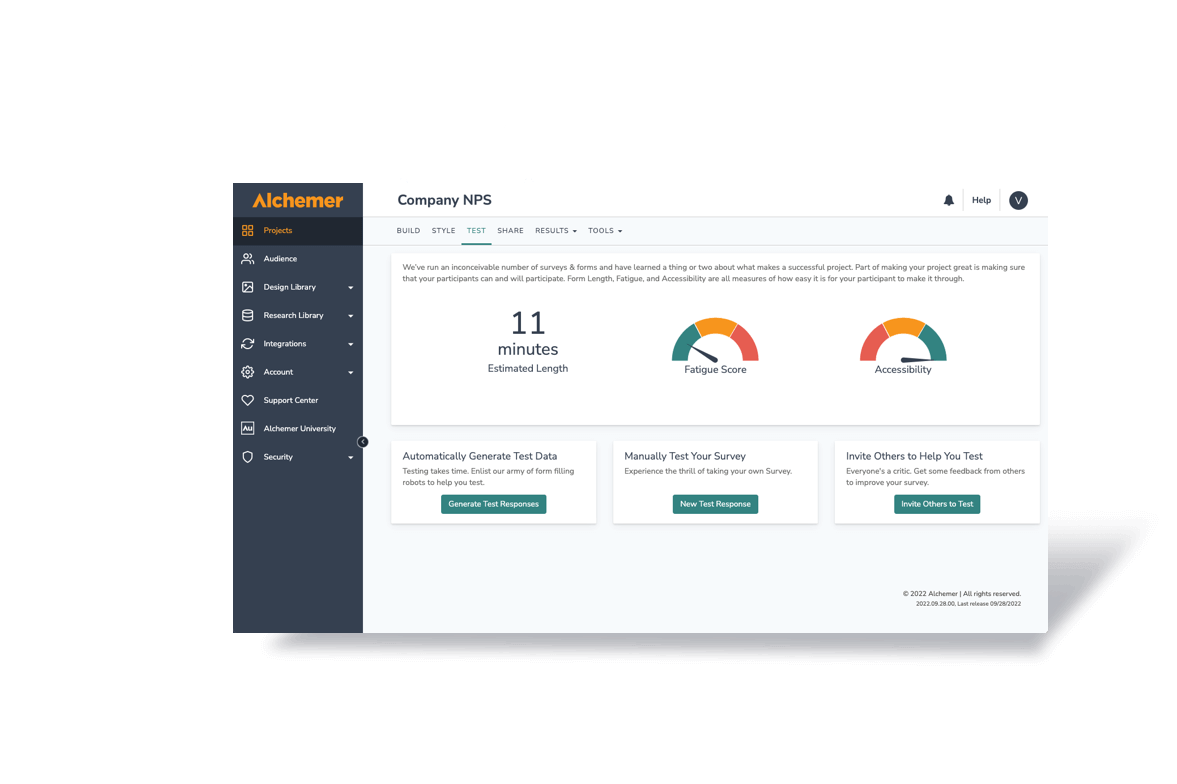At Alchemer, we understand the power of storytelling behind the numbers. Open-ended survey questions have a unique ability to capture respondents’ insights, opinions, and feedback. They allow for richer, more detailed responses than closed-ended questions. Open-ended questions allow for richer data, providing valuable context to help businesses understand customer experiences more deeply.
According to Alchemer’s Benchmark Guide Survey, open-ended survey questions are a staple in online questionnaires. The survey revealed that 64% of respondents use text box questions, while 52% prefer essay-style questions.
These questions provide essential commentary that enhances closed-ended responses. They help researchers explore the underlying reasons behind the quantitative data, allowing for a deeper understanding of the “why” behind the “what.” Yet, the challenge lies in learning how to analyze open-ended survey responses to extract meaningful insights.
Adding open-ended questions to surveys is relatively straightforward. However, the real challenge arises when it comes to analyzing the responses. We discuss techniques to organize, categorize, and interpret open-ended data for maximizing the value of your survey responses.
Why Use Open-Ended Survey Questions?
Open-ended questions can take various forms, including text boxes for short answers and essay questions for longer responses. You can include these questions as an “other” response option in single- or multi-select formats. This provides respondents with the opportunity to share insights that may not fit into predefined choices.
The Benefits of Open-Ended Survey Questions Include:
- Adding Context: Open-ended survey responses give context to quantitative data, revealing insights into customer motivations, attitudes, and expectations.
- Capturing Unpredictable Responses: Predefined answers may miss unexpected insights; open-ended responses allow participants to share nuanced opinions.
- Identifying Emerging Trends: By encouraging respondents to share freely, organizations can uncover new trends and issues. This insight aids in product improvement, enhances customer experience, and optimizes service delivery.
Open-ended survey questions are particularly valuable for capturing customer sentiments in their own words. This feedback offers deeper insights than simple “yes” or “no” answers. It provides brands with a glimpse into what their customers genuinely think and feel.
Challenges of Analyzing Open-Ended Survey Data
The analysis of open-ended survey questions poses significant challenges. Open-ended data is unstructured and can quickly become overwhelming, especially in large datasets.
Open-ended survey responses are different from closed-ended ones. Closed-ended responses are easy to measure and analyze. In contrast, open-ended responses are often long and detailed. They often contain diverse content that requires more nuanced analysis.
One primary challenge of analyzing open-ended data is the effort needed to sort and categorize the responses. Additionally, interpreting these responses requires careful consideration and time. Without clear steps to organize and interpret responses, you can easily lose valuable insights in the noise. However, with the right approach, analyzing open-ended responses can yield critical insights into customer perceptions, experiences, and suggestions.
Step-By-Step Guide: How to Analyze Open-Ended Survey Responses
To effectively analyze open-ended survey questions, it’s often best to use a manual method known as “bucketing.” Here’s a comprehensive step-by-step guide on how to analyze open-ended survey responses effectively.
1. Read Every Response Carefully
The first step in the analysis process is reading each response thoroughly. Although time-consuming, this step is crucial to truly understand the data and spot recurring themes or phrases. As you read, take notes on comments that resonate or stand out as particularly insightful.
Reading each response helps you understand the tone, focus, and intent of the feedback. This familiarity makes it easier to identify initial patterns.
2. Create Initial Buckets or Categories
Once familiar with the responses, start developing buckets—categories that reflect common themes or ideas across the responses. Each bucket should represent a distinct theme, such as “customer service feedback,” “product features,” or “usability concerns.”
This process, called “multi-coding,” allows for flexibility, as some responses may belong in multiple buckets. For example, a single comment might discuss both product usability and customer service, meaning it fits into two categories. Multi-coding is especially useful when analyzing responses to open-ended survey questions. Respondents often express multiple ideas in a single comment, making this technique valuable for capturing all relevant insights.
3. Assign Responses to Buckets
With your categories in place, assign each comment to one or more relevant buckets. This helps organize the data into coherent themes, making it easier to identify prevalent trends. The goal here is to uncover the story behind the feedback by grouping similar ideas together.
Reviewing and Refining Buckets
After assigning all responses to buckets, review your categories to ensure they accurately represent the data. During this step, you may discover that some buckets are too broad and require further division. Alternatively, you may notice that some categories overlap and you should combine them for clarity. Refining buckets is essential for generating precise, actionable insights from the open-ended data.
Example: Refining Buckets in an Open-Ended Survey Analysis
Imagine you’re analyzing customer feedback for a new product. You might initially create buckets such as “pricing,” “features,” “usability,” and “customer support.” However, you may need to divide “features” into subcategories such as “design,” “functionality,” and “ease of use.” Alternatively, you might combine “usability” and “ease of use” if the themes are too similar.
Focus on Meaning and Context in the Analysis
Now that you have categorized your responses, it’s time to contextualize the data. Pair your open-ended survey responses with relevant closed-ended questions to extract actionable insights. d
Using Qualitative Data for Directional Insights
While analyzing open-ended survey questions data, avoid using percentages and focus on the directional aspect of responses instead.
When you have fewer responses, consider mentioning the actual number of people who contributed to specific ideas. This approach can provide more context than relying solely on percentages. This approach emphasizes the sentiment and focus of feedback rather than strict numerical analysis.
Extracting and Using Quotes
Open-ended survey responses often contain direct quotes that highlight key themes. These quotes add authenticity and context to your analysis. Here’s how to use quotes effectively in reporting:
- Cover Page of a Report: Quotes on the cover page add personality to a report, making it more relatable for readers.
- Opening a Presentation: Starting with a compelling quote can immediately capture the audience’s attention and set the tone.
- Introducing Sections in a Written Report: Use quotes to reinforce section themes, adding respondent perspectives to the analysis.
- Building Personas: Quotes from open-ended responses provide depth to customer personas, capturing real customer language and sentiment.
- Mission Statements: Departments or teams can use relevant quotes to align their mission with customer feedback.
By incorporating quotes into reports or presentations, you can effectively showcase the voice of the customer. This practice helps to humanize the findings and make them more relatable.
Leveraging Software and Tools for Open-Ended Survey Analysis
Although manual bucketing can be insightful, analyzing large datasets manually can be impractical. Here, software tools come in handy, especially if the survey includes hundreds or thousands of responses.
Several tools on the market specialize in analyzing open-ended survey questions. They use algorithms to identify key themes, sentiments, and word frequencies within the responses.
Top Tools for Open-Ended Data Analysis:
- Text Analysis Software: Tools like NVivo or Atlas.ti enable researchers to categorize responses by analyzing text patterns. These applications allow for deep qualitative analysis, making it easier to identify key themes and insights within large datasets.
- Sentiment Analysis Tools: Sentiment analysis tools like Alchemer’s Pulse help gauge the emotional tone of responses. They provide a high-level overview of whether sentiments are positive, neutral, or negative. This insight can be critical for understanding customer feelings and attitudes.
- Word Cloud Generators: These tools visualize the most common words used in responses. This visualization provides a quick snapshot of recurring themes and trends within the data. Word clouds can also highlight significant terms that may warrant further investigation.
- Coding Software: Coding software such as Dedoose allows researchers to systematically organize and tag qualitative data. By applying codes to responses, you can easily retrieve and compare related insights, streamlining the analysis process.
- Qualitative Data Analysis Platforms: Platforms like Alchemer offer built-in tools for analyzing open-ended responses. These platforms often include features for text analytics and theme identification. Additionally, they offer sentiment analysis capabilities, making it easier to gather insights directly from survey data.
While tools can speed up the analysis process, a manual review is often necessary. This step helps ensure accuracy and provides important context to the findings. By combining technology with human insight, you can maximize the value of open-ended feedback.
Examples of Open-Ended Survey Questions and How to Analyze Them
To gather valuable insights from respondents, craft open-ended survey questions that encourage detailed answers. Here are some common examples and tips on how to analyze open-ended survey responses effectively:
Example 1: Customer Experience Question
Question: “What do you like most about our product, and how can we improve it?”
- Analysis: Categorize responses into strengths (features, service, pricing) and improvement areas. Look for recurring requests or issues to prioritize enhancements.
Example 2: Feedback on Service
Question: “Describe any challenges you faced while using our service.”
- Analysis: Group responses by service aspects like “response time,” “ease of use,” or “support quality.” Identifying trends in complaints can guide training or operational adjustments.
Example 3: Product-Specific Feedback
Question: “If there’s one thing we could change about our product, what would it be?”
- Analysis: This question can reveal high-priority issues; assign responses to relevant categories such as “design” or “usability” and prioritize common requests.
In all cases, pay close attention to the language used in the responses. Additionally, consider the emotions conveyed, as these can highlight underlying feelings that quantitative data may not capture.
Best Practices for Implementing Open-Ended Survey Questions
To maximize the effectiveness of open-ended survey questions without overwhelming respondents, consider the following:
- Limit the Number of Open-Ended Questions: Open-ended questions require more effort from respondents. Include them only when necessary and avoid making them mandatory.
- Place Open-Ended Questions Thoughtfully: Position open-ended questions near the end of the survey. You can also put them after related closed-ended questions. This lets respondents share more about their thoughts.
- Be Clear and Specific: Ensure that questions are straightforward to minimize confusion, encouraging respondents to provide thoughtful, relevant answers.
- Use “Other” Responses Wisely: Including an “other” field gives respondents the chance to provide input beyond the pre-set options. This feature captures unique perspectives that other methods might not represent.
Conclusion
Incorporating open-ended survey questions is an excellent way to gain a more profound understanding of your customers. By learning how to analyze open-ended survey responses, your organization can extract actionable insights from rich qualitative data.
Embracing both manual bucketing and software tools allows you to manage responses more efficiently. This approach ensures that no valuable insights go unnoticed during your analysis. With an effective analysis strategy, you can unlock the full potential of open-ended survey feedback. This, in turn, allows you to create more impactful customer experiences.



